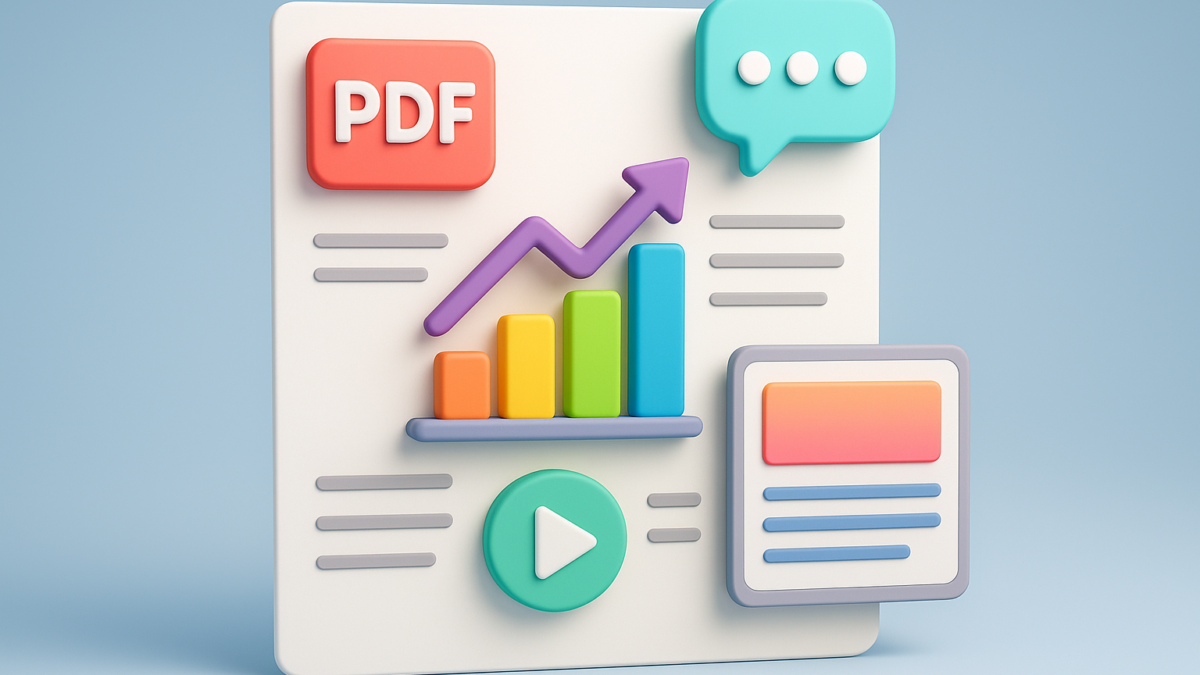The Future of PDF: From Static Documents to Dynamic Experiences
Table of Contents
Introduction
Since its launch in the 1990s by Adobe, the PDF (Portable Document Format) has become the universal standard for fixed-layout digital documents. Contracts, reports, whitepapers, brochures—you name it, it’s likely a PDF.
But as we step into 2025, one thing is clear: the era of static PDFs is giving way to dynamic, interactive, and intelligent document experiences.
This blog explores where PDFs are heading next—and what that means for businesses, marketers, publishers, and everyday users.
Why Traditional PDFs Are No Longer Enough
The core appeal of PDFs—preserving layout and formatting across devices—is still valuable. But in today’s fast-paced, digital-first world, static documents come with limitations:
- No analytics: You can’t track who viewed what or for how long.
- Poor mobile usability: Reading PDFs on smartphones is often clunky.
- No interactivity: PDFs can’t support embedded videos, real-time feedback, or dynamic elements.
- No version control: Once shared, a PDF becomes outdated if your content updates.
These drawbacks are driving industries to rethink how they share knowledge, tell stories, and engage audiences.
Enter the Era of Smart PDFs
Modern PDFs in 2025 are no longer just documents—they’re experiences. Thanks to advancements in cloud computing, AI, and document intelligence, we now see:
Interactive PDFs
- Embed videos, sliders, buttons, and quizzes
- Use anchor links for easy navigation
- Add forms with auto-submission features
Trackable PDFs
- Platforms like DocSend and Adobe Analytics enable viewer insights
- Know exactly who read what, for how long, and where they dropped off
AI-Enhanced PDFs
- Auto-summarization of content
- Smart annotations and highlights
- Real-time translation and voice readouts
These upgrades turn PDFs from passive files into measurable, intelligent assets.
PDF Alternatives Are Gaining Momentum
While PDFs are being upgraded, several platforms are offering next-generation document formats that may eventually replace PDFs altogether:
- Turtl & Foleon: Offer interactive, responsive content experiences for whitepapers and reports
- Notion & Canva Docs: Enable real-time collaboration and embedded media
- Lumin & Scribe: Bring AI-powered workflows to document creation
These platforms are cloud-native, built for collaboration, and mobile-responsive by design—filling the gaps that traditional PDFs can’t.
Additionally Read Also: The Future of B2B Whitepapers: From Static PDFs to Smart Content Engines
The Role of PDFs in B2B Marketing
In B2B, PDFs still dominate gated assets like whitepapers, eBooks, and case studies. But marketing teams are shifting toward formats that improve:
- Engagement (through interactivity)
- Conversion rates (with in-document CTAs)
- Attribution (via integrated analytics)
Instead of simply attaching a static PDF to an email, marketers now distribute smart whitepapers with lead scoring, personalization, and A/B testing built-in.
🔗 See how Whitepapers Online helps businesses turn PDFs into demand-gen engines.
Security, Compliance & Long-Term Storage
Despite emerging formats, PDFs still excel in sectors where security, auditability, and preservation are non-negotiable.
- Legal and government sectors favor PDFs for digital signatures and compliance.
- PDF/A (Archival format) ensures long-term preservation for legal and academic records.
Expect future PDFs to adopt blockchain-based verification, biometric signatures, and automated compliance checks as standard.
What the Future Holds for PDFs
As we move further into 2025, the future of PDFs lies in hybridization—combining their secure, portable nature with modern interactive features and analytics.
Key Predictions:
- Fully responsive PDFs for mobile-first users
- Integrated encryption with identity verification
- AI-generated summaries, voice interactions, and personalization
- PDF-as-a-service platforms for modular creation and editing
Conclusion
The PDF isn’t going away—but it is transforming. Whether you’re a business sharing whitepapers, a designer building portfolios, or a sales rep sending decks, the way you use PDFs will look very different by the end of this decade.
If you want to stay competitive, it’s time to reimagine how you deliver content—moving from static to smart, interactive, and insight-driven documents.
Ready to Upgrade Your Strategy?
Let us help you convert your traditional documents into conversion-ready digital experiences.
👉 Contact our team to get started today.





